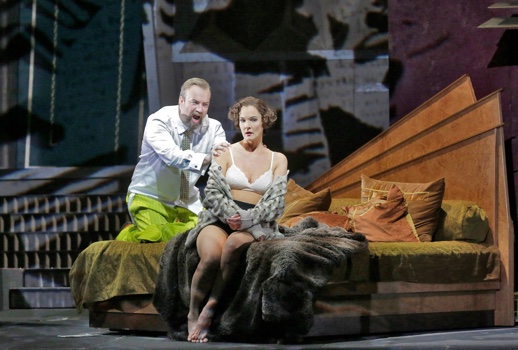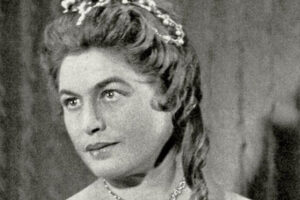

As we are reminded by the singer-host/interlocutor in every broadcast, nothing compares to experiencing the work of great singers, conductors and directors live in an opera house, and ten seasons into the series, fundamental compromise remains part of the package. I tend to find the visual side of the HDs stronger than the auditory. The level of technical polish is high. Cameras disclose subtleties of expression and gesture that might be swallowed up in a big house, and occasionally the filming strengthens a production’s impact. For example, John Doyle’s staging of Peter Grimes was critically panned, even retrospectively acknowledged as a misfire by GM Peter Gelb, who has doughtily defended bad work at his theater long after the fact. With the mediation of the cameras, that Grimes seemed gripping.
The sound, although it may have improved over the years, still is only adequate for providing an “idea” of what is being heard in Lincoln Center. It does not just fall short of what someone would hear from a good seat at the Met; it falls short of the sound of an actual movie. I have seen the broadcasts at three different local venues, and at all three, I have wanted to give them a volume boost. The orchestra, submerged and lacking presence and texture, suffers more than the voices do.
Still, the HD broadcasts allow me and others remote from Manhattan to feel part of the Met audience, connected to what is going on in an interesting era for the theater. By my calculations, about one in five times, I have seen something I would urgently recommend. A slightly smaller percentage of the time, I have seen something that was an endurance test—a tired revival, or a new production I hoped would not survive to be tiredly revived. The remaining HDs, the largest portion, have fallen somewhere in the middle: nothing magical, but satisfactory representations of their operas; big-house professionalism with nothing much going wrong.
In this respect, the HDs probably paint a truthful picture of an entire season’s slate at the Met or any world-class opera house.
Lulu has come around again in a new production by the South African William Kentridge, only the Met’s second production of Berg’s opera. The first, a handsome and lucid in-period show that was a highlight of John Dexter’s Met tenure, served for over 30 years and was given a good telecast in 1980. It was time, perhaps past time, for a fresh look. Kentridge’s first Met assignment, Shostakovich’s The Nose, is deservedly on most short lists of Gelb-era triumphs, and here again the director makes use of elaborate video projections and collage illustrations. The visual overlay is dense, inventive, often dazzling. Kentridge’s artistic imagination, creativity and skill are never in doubt.
However, this broadcast was one that did not improve upon or even match the in-house experience described in laudatory reviews. The cameras took us closer to the production’s human elements, and on paper this sounds sensible enough. Had the acting and the Personenregie been as consistently stimulating as what Kentridge had running parallel, I would have approved. But I kept getting brief glimpses in long shot of splendid stage pictures (usually when a new visual element was introduced), followed by much longer looks at Paul Groves, Johan Reuter and Daniel Brenna emoting (or not) at close range. The production was not focused by the cameras; it was shrunk. My eye longed to settle and take it all in at once, but the field of view was persistently confined to what was not the show’s strong suit.
In fairness, Kentridge’s Lulu is not wholly dependent on his artwork for visual interest. So soon after Catherine Zuber’s Otello costumes looked not only drab but surprisingly chintzy under the scrutiny of the cameras, the attractive colors, lines and fabrics of Greta Goiris’s clothes for Lulu were especially welcome. I also admired Urs Schönebaum’s lighting and the overall set and production designs. This is a high-style show with art deco furnishings and architecture evoking the era of Berg and German Expressionism, and each member of the production team has added something valuable.
In an interview during the broadcast, Kentridge’s lead soprano described him, not unkindly, as “not a regisseur.” Indeed, though his direction here is competent, Kentridge makes less of this psychologically complex material than have many of his living and deceased predecessors, including Dexter, Patrice Chéreau, Graham Vick, Christof Loy and Krzysztof Warlikowski. The murky depths of Wedekind/Berg are a long way from the fizzy shallows of The Nose. If this new production were stripped of its visual wonders, something terrible to contemplate, it would seem less special.
The singing actors assembled for the premiere run are an uneven group, not strongly unified. Marlis Petersen, we were reminded in her intermission interview, has ten Lulu productions to her credit, and this will be the last of them. Her performance on this day seemed to me unfocused, as though she were filling a void with pieces stitched together from the other nine productions. Neither she nor Kentridge appeared to have shaped the attitudes and business into a distinctive protagonist for the occasion. Her energy level is high, she works hard, and she does not lack stage presence (she reminded me of Norma Desmond in coif and, often, posture/expression). But I was not able to say afterward that I had seen a coherent statement about Lulu, or that the character’s irresistible appeal to those around her was understandable. Petersen’s singing, accurate but underpowered in midrange and lacking color throughout, suggested she is relinquishing the role at the right time.
Reuter sang Dr. Schön’s music with unfailingly handsome tone, but his one-dimensional dramatic performance only scratched the surface of a fascinating character. Lulu’s two tenor suitors were still less impressive. Groves’s singing as the Painter was labored, while Brenna’s Alwa never seemed more than a cipher. Susan Graham provided a needed jolt of star power in the latter two acts. The mezzo seized opportunities as Countess Geschwitz, with poignant acting and discernment of phrasing making up for patches of pallid tone and some loss of amplitude. The most stylish performance of any of the principals was that of 78-year-old Franz Grundheber as Schigolch. The role flatters his present vocal estate, and this esteemed Wozzeck of bygone days moved easily through a musical and theatrical world he obviously understands and loves. Grundheber’s witty turn—a twinkle-eyed grandfather on whose lap no one would be advised to sit—was a welcome reunion with a singer who had not appeared at the Met since 2004.
There was much to enjoy in briefer performances. Martin Winkler’s exuberant and commanding work as the Animal Tamer/Acrobat will linger in the memory, as will Elizabeth DeShong’s Dresser/Schoolboy/Page. In particular, Ms. DeShong’s rambunctious Schoolboy was among the best I have heard or seen. Bass Julian Close, the Theater Manager/Banker, made much of little in a promising Met debut. After a few lines from him, I made a mental note to get his name from the web site, if I could not from the absurdly fast closing-credits scroll.
Conductor Lothar Koenigs was in the difficult spot of taking over an entire run planned for the man who holds the title of Met music director, James Levine. Some in the Metcentric bubble still talk of Berg’s 80-year-old masterpiece as if it is a daringly avant-garde pet project inextricably tied to Levine, rather than a much-recorded opera done these days at every major house and many minor ones. Koenigs, an experienced Berg conductor, did commendable work in the circumstances. The Met Orchestra, which at times in recent seasons has brought to my mind a magnificent garden just beginning to get weedy (as in the hung-over-sounding Trovatore HD last month), played well for him. This was a looser-limbed, more lyrical Lulu than Levine’s sumptuous, very late-Romantic ones.
One feature of the production almost universally criticized is the use of two mimes constantly on the sidelines, a hunchbacked butler (Andrea Fabi) and a pianist/dancer (Joanna Dudley), the latter acting as a Lulu double. I will be perverse: with their roles edited down by the cameras, they were grace notes of effective weirdness. Ms. Dudley’s big moment, in which she silently acted out one of Berg’s haunting interludes, was enigmatic, graceful and expressive—qualities I associate with Lulu itself, and got only fitfully from this broadcast. Perhaps a revival cast will supply those qualities in greater abundance.
The showing was well attended at a shopping-mall theater here in flyover county. I would estimate that the auditorium was at nearly three-quarters capacity at the start. Some viewers jumped ship between acts, something that happens at every Met HD, but there was good crowd retention. The libretto’s dark humor seemed to land; there was laughter at the usual spots, such as Schön’s elliptical reference to the Painter’s fate. Most of the remarks I overheard during intermissions and at the end, some from obvious newcomers to Lulu, were favorable. Although seniors dominated the turnout as usual, there were attendees who appeared to be in their twenties and thirties as well.
An encore showing is scheduled for the evening of Wednesday, December 2, and despite my mixed review, I encourage readers who missed Saturday’s Lulu to see it for themselves. No matter your level of familiarity with Berg’s opera, you are unlikely, at least, to be bored.
Photo by Ken Howard/Metropolitan Opera.
























Comments